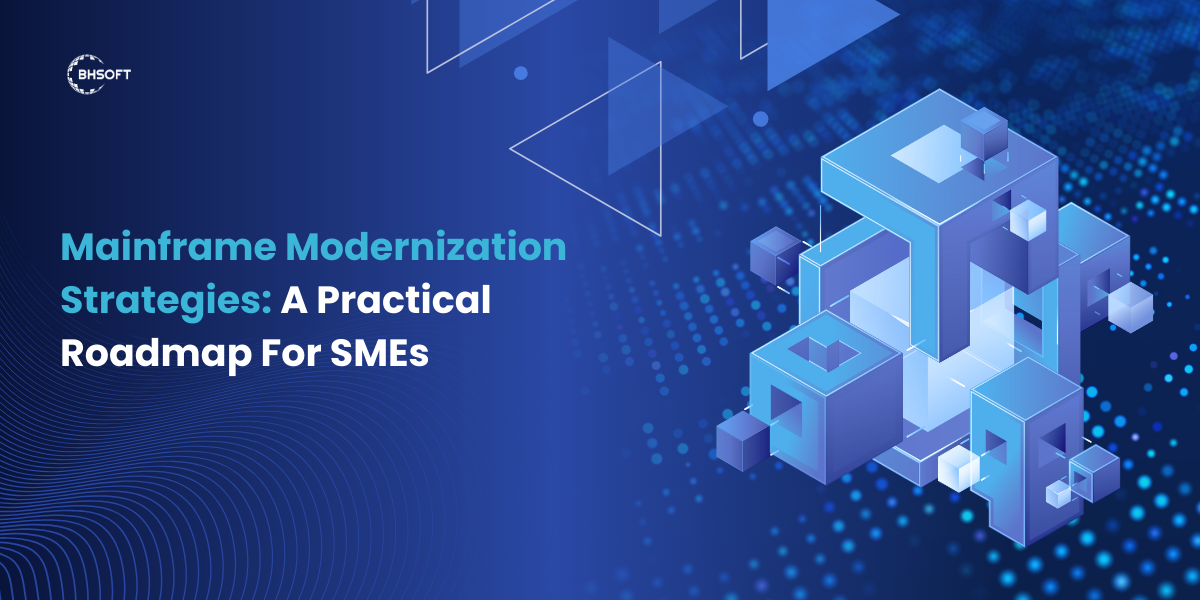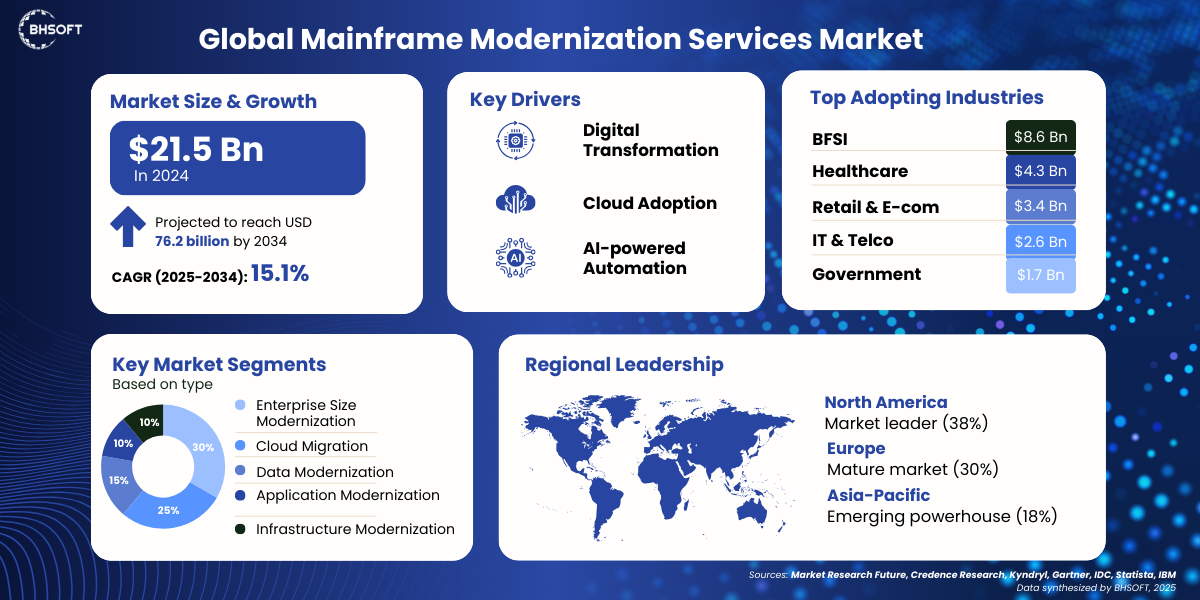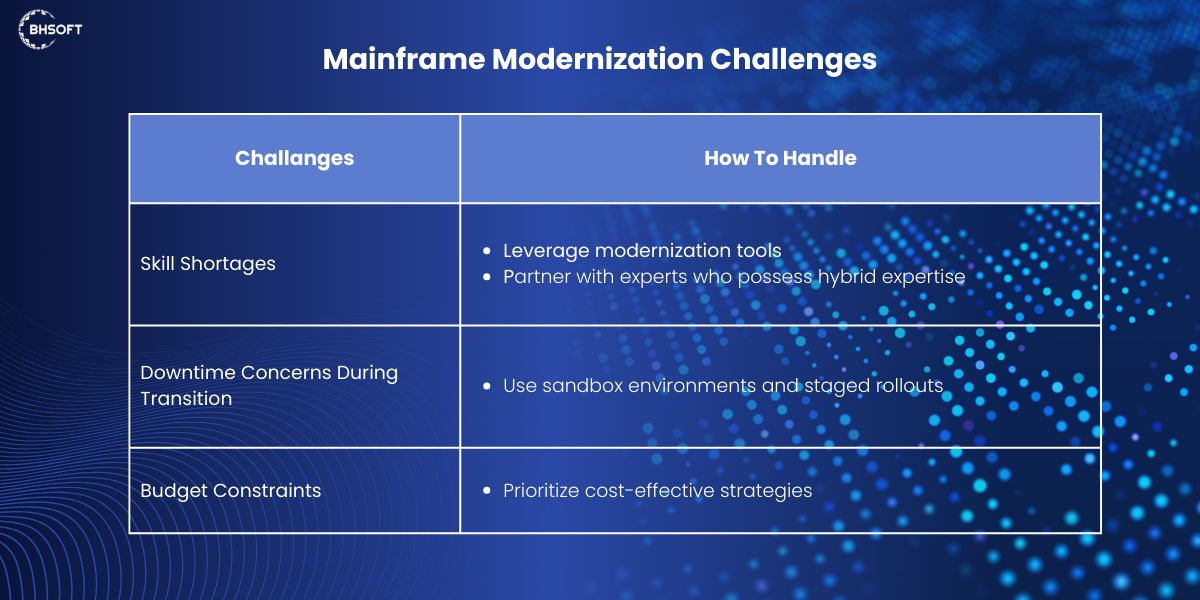Home > Insight > IT Business
Mainframe Modernization Strategies: A Practical Roadmap For SMEs
5 minutes read
Audio description available
April 16, 2025
Mainframes have powered mission-critical operations for decades. In fact, nearly 71% of Fortune 500 companies rely on mainframes to process core transactions. However, as businesses accelerate digital transformation, these legacy systems are starting to show their limits. From rising maintenance costs to integration challenges and talent shortages, the case for modernization is no longer a question of if, but how.
Modernizing legacy infrastructure may seem complex, especially for SMEs with leaner IT resources. But with the right approach, it’s entirely possible to upgrade systems, reduce risk, and improve performance, without starting over.
In this guide, we’ll walk through practical mainframe modernization strategies for SMEs, with a focus on flexibility, cost efficiency, and business continuity. Let’s dive in!

What Is A Mainframe Application?
A mainframe application is a business-critical program that runs on a centralized mainframe system. These applications are typically built to handle large volumes of data with high reliability and speed. For many SMEs, mainframe applications manage essential functions such as financial records, payroll, order processing, inventory control, or customer data.
Historically, these systems were chosen for their performance, uptime, and security. Mainframe applications often run on legacy code—usually COBOL or PL/I—and have been maintained over many years to support core business operations.
While they remain stable and trusted, these applications can also be difficult to update or integrate with modern platforms. As business needs evolve, legacy mainframe systems can limit flexibility, scalability, and access to new technologies, prompting many SMEs to explore modernization options.

Why Modernize Your Mainframe?
Mainframes have served businesses reliably for decades. However, as customer expectations and digital channels multiply, they often become a bottleneck to growth. For SMEs, the cost of maintaining outdated infrastructure can quickly outweigh the benefits.
According to IDC, organizations that begin mainframe modernization projects experience an average 30% reduction in operational costs and a 40% improvement in release frequency within the first year.
Common pain points include:
- Rising hardware and licensing costs.
- Inflexibility with cloud-native tools.
- Difficulty accessing and analyzing data.
- Shortage of mainframe development talent.
- Risk of service disruptions from outdated components.
You may be interested: Replacement vs Modernization Legacy Systems: Which Is The Right Path For Your Business?Common Approaches To Mainframe Modernization
There’s no single path to mainframe modernization, especially for SMEs. Most strategies fall into one of six categories. You can learn more about these strategies in detail in our guide on legacy application modernization.
Approach | What It Does | When It’s Useful |
Rehost | Move workloads to cloud infrastructure | Quick savings, no code changes |
Replatform | Upgrade runtime or OS while keeping core logic | Improve performance with low disruption |
Refactor | Modularize and optimize legacy code | Adds flexibility for future updates |
Rewrite | Rebuild systems from the ground up | When legacy code is unsustainable |
Replace | Migrate to SaaS or COTS software | If new tools meet current needs |
Retire | Keep or sunset specific functions | Manage scope and minimize risk |
Top 6 Mainframe Modernization Strategies for SMEs
When it comes to mainframe modernization strategies for SMEs, the goal is clear: modernize legacy systems without risking business continuity, and do so in a way that’s cost-effective and scalable. Below are some of the most effective strategies for achieving this balance. These strategies are designed to help you reduce risk, improve system performance, and future-proof your IT infrastructure modernization while maintaining control over costs and resources.
Rehost For Immediate Cost Savings
Rehosting, or “lift and shift,” involves moving mainframe workloads to cloud infrastructure with minimal changes to the application’s underlying code. This is one of the fastest ways to reduce infrastructure costs while still maintaining the core functionality of your existing systems.
Rehosting is a cost-effective approach that helps SMEs reduce their reliance on legacy hardware. It provides immediate savings, allowing businesses to cut costs on on-premises infrastructure and leverage the scalability and flexibility of cloud services.
" Research shows businesses that rehost mainframe workloads can see a 50% reduction in infrastructure costs within the first year. "
This method is ideal if you need to reduce operational costs quickly without disrupting daily business operations.
Replatform for Better Performance with Low Disruption
Replatforming involves upgrading your system’s underlying infrastructure, such as moving to a modern operating system or runtime, while maintaining the core business logic of the application. This approach improves performance without requiring a complete rewrite of your code.
Replatforming provides an effective way to improve system performance with minimal disruption. It helps you modernize the infrastructure to be more compatible with current technologies, allowing easier integration with cloud and other modern tools.
Use replatforming when your system still works well but needs a performance boost or a more modern infrastructure that integrates better with today’s technology.
Refactor for Long-Term Flexibility
Refactoring involves restructuring the application code to improve its flexibility, scalability, and maintainability. This strategy often breaks down monolithic mainframe applications into smaller, modular components, enabling you to implement microservices or cloud-native architectures over time.
Refactoring offers long-term benefits for businesses that want to evolve. By modularizing the code, businesses gain the ability to scale services independently, optimize development cycles, and improve reliability.
This method is ideal when you want to set your business up for long-term success, allowing your systems to become more agile and adaptable to future needs.
Companies that have refactored their legacy systems report faster deployment cycles and increased uptime, providing more room for innovation and growth.
Learn more: Healthcare IT consulting services for compliance regulation
Rewrite for a Clean Break from Legacy
Rewriting involves rebuilding your mainframe applications from the ground up, using modern programming languages and frameworks. This is the most comprehensive approach to modernization, but it provides a clean slate and removes all dependencies on outdated infrastructure and code.
Rewriting may be necessary when your legacy system is no longer sustainable or capable of supporting future business needs. While it’s the most resource-intensive strategy, it allows you to fully embrace modern technologies that are better aligned with your current and future business goals.
Best practice for rewriting is when your existing system is too fragile, outdated, or unable to scale with your growing business demands.
Replace With SaaS Or COTS Software
Replacing legacy mainframe applications with commercial off-the-shelf (COTS) software or Software-as-a-Service (SaaS) solutions involves switching to pre-built software solutions that can provide the same functionality as your legacy system.
This strategy is typically the quickest way to modernize and is ideal when there are modern, affordable alternatives available. SaaS solutions often provide greater scalability and less maintenance than legacy systems. Many SMEs that transition to SaaS platforms report 28% lower maintenance costs within the first year.
If a SaaS or COTS solution meets your business needs, replacing the legacy system is often a smart move for reducing maintenance overhead and gaining access to modern tools.
Retain/Retire Specific Functions
Some parts of your mainframe application may still be necessary, while others can be retired or replaced. This approach involves selectively modernizing your system by keeping the parts that still provide value and eliminating or replacing the parts that no longer serve the business.
Selective modernization helps SMEs focus their resources on the most critical parts of their infrastructure. By retiring legacy functions that are no longer needed, businesses can simplify their systems and reduce complexity.
This strategy is ideal when you have a system with some outdated functions that can be retired, while keeping essential elements intact.
Learn more: DevOps Implementation Services in Vietnam
Challenges To Expect & How To Handle Them
Modernizing your mainframe system can feel like a daunting task, especially for SMEs with limited IT resources. However, by understanding and anticipating common challenges, you can better prepare for a successful transformation.

Skill Shortages
One of the most significant hurdles in mainframe modernization is the shortage of skilled mainframe developers. According to a recent study, 58% of CIOs identify this as a major roadblock in their modernization efforts. Given the reliance on legacy systems, there is often a gap between the technical skills needed to manage these systems and the resources available within smaller organizations.
→ To overcome this, SMEs can leverage modernization tools that automate parts of the process or partner with experts who possess hybrid expertise, blending knowledge of legacy and modern systems. This ensures that modernization is carried out efficiently without compromising the quality or continuity of operations.
Downtime Concerns During Transition
Another common concern is downtime. Legacy mainframe systems often support critical workflows, and any disruption can lead to significant business interruptions. For SMEs, even a small amount of downtime can result in lost revenue and damage customer trust.
→ To mitigate downtime, it’s essential to use sandbox environments and staged rollouts. By testing new systems and updates in a controlled environment before full implementation, SMEs can ensure that the transition doesn’t disrupt daily operations. This phased approach also allows teams to identify and fix issues early, minimizing the risk of extended outages.
Budget Constraints
For many SMEs, budget constraints are a constant challenge. Digital transformation projects can be expensive and time-consuming, and smaller businesses often struggle to justify the cost of a full-scale modernization.
→ Prioritize cost-effective strategies such as API integration or data migration. These methods enable businesses to modernize key systems incrementally, reducing costs while still making progress toward more scalable, flexible solutions. By focusing on areas that deliver the most immediate value, SMEs can begin the modernization process without significant upfront investment.
How To Choose The Right Strategy
Choosing the right modernization strategy for your business requires a thoughtful and strategic approach. Here are some suggestions for you:
Step 1: Assess Your Current IT Landscape
Start by identifying the outdated systems that are holding your business back, the bottlenecks in your workflows, and any technical debt accumulated over time. This assessment provides a clear picture of which applications and systems need to be modernized first. By prioritizing critical systems, you can allocate resources where they’ll have the most significant impact.
Step 2: Set Clear Modernization Goals
Next, establish clear goals for your modernization project. What are you hoping to achieve? Are you aiming to lower costs, improve scalability, or enhance integration capabilities? These goals should align with your overall business objectives, and clearly defining them will ensure that you stay focused during the transformation process.
Step 3: Map Your Goals to the Right Strategy
Once you’ve set your goals, map each one to the appropriate strategy. For example, if cost savings are a priority, rehosting may be the best option. If you’re looking for more flexibility and long-term scalability, then refactoring could be the right choice. For improved reporting and data analytics, data migration strategies should be your focus.
Step 4: Start with a Low-Risk Pilot
It’s always a good idea to start with a low-risk pilot project. Choose a non-critical system or part of your infrastructure to modernize first. This pilot will help you gain insights into how the process works, identify potential challenges, and refine your approach before tackling more critical applications.
Step 5: Choose the Right Partners for Success
Finally, choosing the right partners for your modernization journey is crucial. Look for consultants or service providers who have experience with both legacy mainframe systems and modern technology platforms. A trusted legacy transformation partner will guide you through the complexities of modernization, ensuring a smoother transition and helping you avoid common pitfalls.
Final Thoughts
Modernizing your mainframe systems doesn’t have to be a daunting task. With the right mainframe modernization strategies, SMEs can overcome legacy challenges, streamline operations, and unlock new capabilities for future growth.
By adopting a strategic, businesses can modernize their systems step by step, minimizing risk and maximizing value at every stage. It’s about making smart, informed decisions that align with your unique business goals.
At BHSOFT, we specialize in top-notch legacy modernization and transformation services, providing SMEs with tailored mainframe modernization strategies that drive efficiency and ensure long-term success. for expert guidance on your modernization journey.

